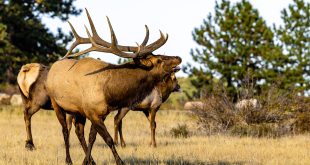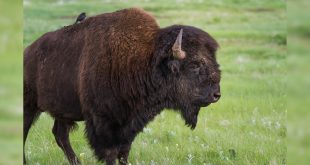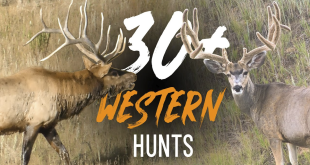
If you’re anything like me you are searching for the perfect hunting arrow. The deal is, each and every archer is different, which in turn makes each arrow different. Everyone’s draw length, poundage and performance is different. Also, every bowhunter’s needs are different. Do you plan on hunting Elk or moose, or are you a deer and antelope guy? Do you hunt where there is a lot of wind or in the timber where it’s fairly calm? You see, each arrow is archer- specific. Ultimately, you want an arrow that is going to fly true and penetrate deep with hopefully a pass- through, leaving a good blood trail. Follow along as I break down the components of a hunting arrow and give you the information to build your ultimate hunting arrow.

Spine
Spine—a shaft’s lateral stiffness— is the most important factor when building your arrows. Your spine is the flex in your arrow flexes as it absorbs the energy from your bow. A properly spined arrow bends back and forth as it’s released from the bow, creating perfect arrow flight. Your spine needs to match your setup or you simply are not getting the best performance out of your arrow or your bow. When you have the correct spine, your arrows react to the bow and create the most forgiving setup.
There are a couple of ways to match your spine to your setup. All arrow manufacturers make a spine chart with poundage and length. This works, but there are so many factors that affect spine. Say you have a 70-pound bow;, well, a lot of times that bow is pulling 73 pounds,; thatwhich makes a huge difference in your spine. Also, if you shoot 125- grain heads on the front, that affects spine as well. Now you can always adjust your spine by cutting your arrow. The shorter you go the stiffer the spine needs towill be. I like to use the shortest arrow I can. The reason I do that is the shorter the arrow the less wind drift will affect it. Okay, I am getting off topic here, but you want to find the perfect spine for your bow. You can test this by shooting different length arrows through paper to find the most consistent paper tear.
I have found an archery cheat for finding correct spine:. I use Archer’s Advantage, a computer program. With this program, you can enter all the specifics of your bow and your arrow. You enter the make, model, and components and this program will tell you the exact length your arrow needs to be to fly perfectly. It’s an incredible program and I recommend it highly.

Weight
The weight of your arrow plays a huge role in your performance. Again, everyone’s setup is different and will perform differently, so optimum weight is dependsent on your specifics. There are a couple of equations to figure out the best weight for your specific arrows. You can use kinetic energy and momentum calculators to find out which weight is going to perform the best out of your bow.
I will tell you right now, the heavier the arrow the more momentum you will get;, it’s physics. That’s why the trad guys shoot super heavy arrows because their bows don’t create the energy of today’s compounds. They make up for it with weight to get the penetration they need. Also, a couple of added benefits of a heavy arrow are that they quiet down your bow and are less affected by wind.
Okay, so with those advantages why wouldn’t we all shoot a beast of an arrow?. The reason for me is with a compound I am shooting longer ranges, –40, 50 and 60 yards. At these distances the heavier arrows are moving slower which creates more drop in-between yardages. So, if you’re off on your yardage by a yard or say two or three you are going tomight make a bad shot or miss all together. Bowhunting for me is all about accuracy and hitting the spot I am aiming at. I want to create the most forgiving set up I can, and if my arrows are too heavy, I feel like I lose that forgiveness.
Don’t get me wrong, I do like a heavy arrow. It’s just that there is a fine line for me finding an arrow that’s going to penetrate well under any circumstance and be forgiving at any distance. Also, a slower, heavier arrow gives your quarry more time to jump the string and get out of the way of your arrow.
So, the question remains:, what is the perfect weight? Again, this is specific to you and your set –up, but I will let you know what works well for me. I shoot a 26.5- to 27-inch draw length pulling roughly 70 pounds. I have used arrows from 400 grains to 500 grains. I have found the perfect weight for my arrows at 425 to 450. This seems to be the happy medium for me. I get great penetration on all animals including elk, most of the time a complete pass- through. This weight is also really forgiving, and if I am off by a yard or two it still hits close enough to center.

Make and Model
There are so many options when choosing the arrows you are going to shoot. Let’s start with the diameter of the arrow. The micro- diameters are all the rage right now and for good reason. That smaller diameter is less aeffected by wind drift, and there is less surface area, resulting in less drag when you hit something, creating better penetration. The deal is that these arrows are not cheap. I say get the smallest diameter you can afford as you do get added performance from them. Really though, a few hundredths of an inch aren’t going to make or break you. You can get some slightly larger diameter arrows that will shoot great and save you some money.
The next thing I look at when making my choice is weight tolerance and straightness. I want my weight to be as consistent as possible. I look for low numbers here as I need my arrows to end up within a grain of each other;, otherwise they get culled. There are some cheats here like weighing your shafts and your components and matching up heavy shafts with light components and vicse- versa. It seems no matter how good your weight tolerances are, you end up with some discrepancies. Even something as small as how much glue you use makes a difference.
Next, I look at straightness tolerance;-, you also want a low number here. Honestly, I don’t think I shoot well enough to notice the difference between a .001 or .005 straightness tolerance. I do, however, want the straightest arrows I can get, but there are also some cheats here too. I cut both the back and the front of the arrow as the center is usually the straightest part. Arrows come in 30” or 32” stock lengths and I only need 26”, so I cut the straightest part of the arrow.
You do want quality component on your arrows. I like a good, consistent nock. I have seen some before that are flimsy and can bend and break. This does not make for consistent shooting and can be downright dangerous. I also want a tough outsert or insert. I want my tips to spin true and I want them to be burly. I have had inserts before that exploded when they hit something hard. My favorite design right now is to have a good outsert and then a sleeve that covers the connection between the shaft and insert, and there are a lot of companies that have their own spin on this. I have shot them into a concrete wall and changed the tip and it’s good to go;, that’s what you are looking for!
The last part of your arrows is the steering, the fletchings. We have already talked about spine and how it creates perfect arrow flight;, therefore, we don’t need massive amounts of steering. However, the bigger the blades on your broadhead the more steering you will need. Those blades catch wind and try and to steer the arrow;, you want to control and override this. For most set ups, low profile two- or three three-inch vanes will do the trick. With these smaller profile vanes, you get less wind drift and wind drag;, that’s their benefit. I also like to use a strong helical on my vanes as it gets your arrow spinning which stabilizes it. With the micro- diameter arrows, you are limited to how much helical you can get, but I get as much as I can while still getting a solid glue and contact with the shaft.

The last thing to consider is the color and whether or not you are going to shoot a wrap or cresting. I like a wrap as it adds a bright color to the back of my arrow. I also like a bright vane as I can see it in flight and better judge the hit I make on an animal. Everyone is different, but I have always liked a bright green or yellow wrap and fletching.
That’s my breakdown on building the perfect hunting arrow. It makes a huge difference to design and use an arrow that is built for your specifics. Creating the most forgiving arrow for your bow pays huge dividends in accuracy and performance. Go through and think about your setup and make sure you are getting the most out of it. Western bowhunting is a game of inches, so do everything in your power to be on the right side of that equation!
CHECK OUT OUR EASTMANS’ ELEVATED PODCAST FOR MORE TIPS AND TICKS LIKE THESE!
 Eastmans' Official Blog | Mule Deer, Antelope, Elk Hunting and Bowhunting Magazine | Eastmans' Hunting Journals
Eastmans' Official Blog | Mule Deer, Antelope, Elk Hunting and Bowhunting Magazine | Eastmans' Hunting Journals





One comment
Pingback: The Ultimate Hunting Arrow: Making A Killer Point - Eastmans' Official Blog | Mule Deer, Antelope, Elk Hunting and Bowhunting Magazine - Florida News